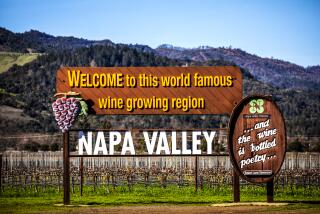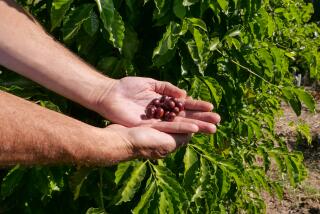Like California Syrah? Try Its French Ancestor
California Syrahs are becoming popular, but we shouldn’t overlook their French parents. It is interesting to taste the two side by side and see how they compare.
Syrah’s home in France is the northern Rhone Valley. For much of the 20th century, these wines--particularly Hermitage and Cote Rotie--were mentioned in the same breath as the reds of Bordeaux and Burgundy. Today, for the most part, they are overshadowed.
Still, there are a few northern Rhones that can command the same prices as all but the most highly prized wines from Bordeaux and Burgundy. Producers such as Guigal, Chave and Jaboulet are making outstanding wines in Hermitage and Cote-Rotie, as well as in hitherto less well-known villages such as Cornas, St. Joseph and Crozes-Hermitage
How do these Syrahs compare with the Californians? Generally, they are less rustic than their New World counterparts. They may be less full in body and lower in alcohol, but they yield nothing to California in terms of intensity and complexity.
** 1998 Chapoutier Hermitage “La Sizeranne,” $50. This full-scaled Syrah certainly lives up to our expectations for Hermitage. Unlike so many of its California kin, it is able to find weight and plenty of fruit without resorting to high alcohol and searing heat. It was one of the few Rhones in our tasting to exhibit the gamy edge that is so common in California and Washington Syrahs.
1999 Bernard Chave Crozes-Hermitage, $12. Chave is poorly represented by this inexpensive offering, which heads off into herbs and earth rather than the more typical spice and blackberry fruit of Syrah. This wine reminds us that, despite occasional successes, Crozes-Hermitage is a flatland appellation, and its wines bear little resemblance to the real Hermitage from the hillsides above it.
** 1999 August Clape Cornas “Renaissance,” $40. Cornas, in the rugged hillsides south of Hermitage, can have much the same power as its storied neighbor, though usually with less finesse. Nevertheless, this rich, flavorful bottling from so-called “younger” vines (about 20 years old) is actually less coarse and gruff than the Chapoutier Hermitage above. It is filled with solid fruit and complex notes of smoke and spice. If not up to decades of aging, it still offers lots of potential for those who would like to lay some away.
$** 1999 Philippe Faury St. Joseph, $24. From an appellation that is even farther south and embraces a variety of growing settings, this wine is so ripe and rich that it challenges its more expensive neighbors. It carries a bit more flesh than they do, and is reminiscent of California in that regard, though it is less tannic and coarse in construction. California producers could take a lesson here.
* 1998 E. Guigal Cote Rotie “Chateau d’Ampuis,” $80. This exciting effort and the Bernard Guy wine that follows are examples of the depth and richness found in Cote Rotie. For Chateau d’Ampuis, Guigal blends fruit from several of his top vineyards. In this vintage, the wine takes on extracted, ripe blackberry flavors with seasonings of cocoa, vanilla and dark roasted coffee. Its tannins are substantial and some of the typical Cote Rotie raciness is lost to oak and ripeness and for the moment that keeps it from a second star. Still, this wine may soften into great beauty with aging.
** 1999 Bernard Guy Cote Rotie, $38. Some Syrah lovers insist that the grape can combine the sinew of the best Cabernet Sauvignons and the suppleness of the best Pinot Noirs, and this is one wine that bears that out. This is a Syrah of remarkable elegance. Its perfume of raspberries, violets and sweet spices are followed on the palate by a wine that is wholly lacking in coarseness yet has a solid spine of integrated tannins.
1998 Paul Jaboulet Aine Hermitage “La Chapelle,” $70. This vintage of a fabled combination of producer and vineyard winds up surprisingly overdeveloped and somewhat enervated, even while displaying the weight and density of Hermitage. Its first notes of fruit and roasted spice are right on course, but then the wine’s acidity butts in and its early fruit gives up a bit too easily.
$ 2000 Earl Georges Vernay Vin de Pays des Collines “Rhodaniens,” $10. This is an example of the values that can occasionally be found when good grapes are planted in areas with little pedigree but much potential. It is a mid-sized, plummy wine with a bit of varietal black pepper spice and a bit more richness in body and texture than it has in flavor.
1998 Alain Voges Cornas, $30. This is Cornas as it has been known forever. Bold, tough, ripe, deep and very much wanting polish, it’s more rustic than coarse or crude. Its pleasing fruit and evident tannin come without the heat that accompanies many West Coast wines.
*
Symbols
***A world-class wine, superb by any measure, the top 1% to 2% of all wines tasted.
**An exceptional wine, well worth the effort to find, 10% to 12% of wines tasted.
*An admirable wine, tasty, focused, attractive, about 25% of wines tasted.
No Rating: The best are quite pleasant and can be good buys when moderately priced.
$Good value for the money.
Below average quality, to be avoided.
*
This column is based on tastings conducted by Connoisseur’s Guide to California Wine, a monthly newsletter devoted to the critical review of California and West coast wines. Readers of The Times may obtain a sample copy by sending their name and address to: CGCW, P.O. Box V, Alameda, CA 94501, by calling or faxing (510) 865-3150 or by e-mailing [email protected].
More to Read
Eat your way across L.A.
Get our weekly Tasting Notes newsletter for reviews, news and more.
You may occasionally receive promotional content from the Los Angeles Times.








